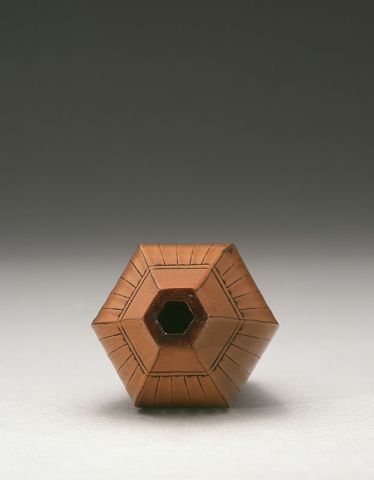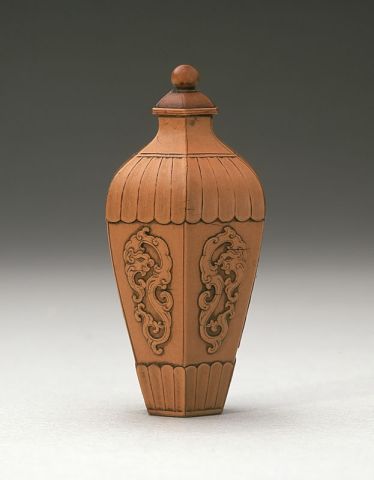

Bottle ID: 670
VENEER, MEIPING, CARVED
Date: 1740-1795
Height: 53 mm
Bamboo veneer (zhuhuang), of hexagonal meiping form tapering to a hexagonal flat base and continuing with the hexagonal panels forming the shoulders and neck, each flat vertical panel with a carved and applied archaistic kui dragon, between bands of slender petals encircling the shoulders and foot, the original matching stopper carved with a finial on top.
Imperial, attributed to the Palace Workshops.
Similar Examples:
Snuff Bottles - The Complete Collection of Treasures of the Palace Museum, Vol. 47, Beijing, 2003, p. 249, no. 383.
Lawrence, Clare. Miniature Masterpieces from the Middle Kingdom - The Monimar Collection of Chinese Snuff Bottles, 1996, pp.58-59, no. 23.212.
Zhongguo binyanhu zhenshang [Gems of Chinese Snuff Bottles]. Edited by Geng Baochang and Zhao Binghua, 1992, no. 437.
Provenance:
Asian Art Studio
Jing Hing Co., Ltd.
A Private Southern Californian Collection
Sotheby Parke Bernet, New York, June 9, 1976
Considering the highly imperial nature of this bottle, there seems to be a decent number of similar examples published both in private and museum collections, most with their original matching stoppers, as is the case here. This not only indicates the appeal of this rare group but also raises the possibility that they were made in the 18th century Palace workshops in sets, which stayed together until the bottles were removed from the Court. Both of the Imperial Collections in Beijing and Taipei have published examples identical to the Crane bottle, and also examples of different forms, but with stylistically comparable decoration. Other scholars’ works of art exist in bamboo veneer, clearly made in the same workshop at around the same period, such as belt buckles, paperweights and a small group of exquisite miniature furniture. The method used to make bamboo veneer seems to have developed for a short period in the Palace workshops, but remained almost exclusively a Palace technique. The interior surface of the cortex would be stripped, soaked and pressed flat and then laid as a veneer on the base material, which was often wood or bamboo. A second layer of veneer would be used for the main decorative elements by carving and applying the separate piece to the first veneer.
< Back to full list
 English
English 中文
中文